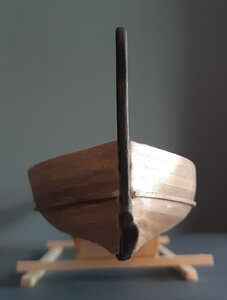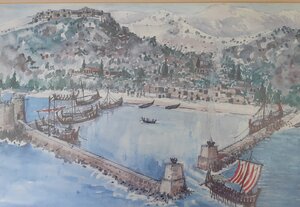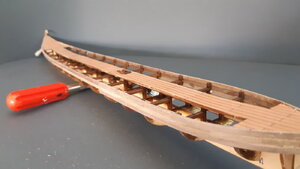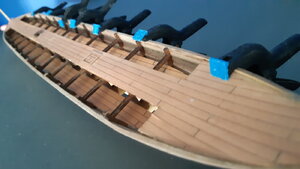-

Win a Free Custom Engraved Brass Coin!!!
As a way to introduce our brass coins to the community, we will raffle off a free coin during the month of August. Follow link ABOVE for instructions for entering.
-

PRE-ORDER SHIPS IN SCALE TODAY!
The beloved Ships in Scale Magazine is back and charting a new course for 2026!
Discover new skills, new techniques, and new inspirations in every issue.
NOTE THAT OUR FIRST ISSUE WILL BE JAN/FEB 2026
You are using an out of date browser. It may not display this or other websites correctly.
You should upgrade or use an alternative browser.
You should upgrade or use an alternative browser.
Building Odysseus ship (A penteconter)
Did you paint these?The ancient port of Amathus in Cyprus
I really do enjoy paintings depicting what ancient ports, boatyards, etc looked like based on archeological and historical evidence.
No I have not paint it myself. It was painted by a Dutch artist who lived in Cyprus, according to the the instructions of the head of the archaeological team that conducted the excavations at the acropolis of Amathus.
If you fly by plane over the area you can still see the foundations of the port on the sea bed.
If you fly by plane over the area you can still see the foundations of the port on the sea bed.
Ah yes, another excellent build to follow along with. I do love a model build with a dose of history put in. 
This is what I'm talking about. Real history, real ships, really a good project. Thanks for sharing.
hot water and a pkank bender.
My attemps at planking haven't ever turned out too good, but that me messing it up. I have used amonia mixed into the hot water
to achieve easier bends though. My understanding is the amonia breaks down the bonds inside the wood that makes it not want
to bend. Perhaps a little household amonia would help you as well.
Perhaps. Or just leave it in the water longer... It all depends on the type of wood and the thickness of the plank.Perhaps a little household amonia would help you as well.
- Joined
- Apr 20, 2020
- Messages
- 6,220
- Points
- 738

I recommend using hot steam for a few minutesPlanking is slow but steady. Planks are to thin and not flexible... so I.have already wasted some material, even though I used hot water and a pkank bender. Due to the length I also need more than.one plank for its row. There are 17 rows on each side, so it seems I will use about 50 planks.View attachment 166252
never heard of using ammonia
I think I got that tip from reading a book by Frank Mastini years ago.
Maybe. I not a health nut, but ammonia must be used cautiously. Ensure good ventilation and fan, both when soaking and heat-bending. I'd prefer soaking in hot water, reheated as necessary.My understanding is the amonia breaks down the bonds inside the wood that makes it not want
to bend. Perhaps a little household amonia would help you as well.
from todays Jerusalem Post website: "7th century shipwreck, Ma'agan Michael"Upper deck, or the bridge connecting forecastle and quarterdeck/poop deck, is done. Now is time to begin planking.
That said, appears to me that I have to explain that this is not the way a penteconter was build. On the contrary, at those ages, it was the other way around, It was build with the shell-first construction method. That is the planking was made prior to the framing of the ship. The frames were coming after planking. Of course here I could not follow this method so I proceed as the usual method frame first and then planking, that is the method that came later, after the 7th century bc.
For the planking there is discussion. Were the ships planksthose days joined together with mortise and tenons or if they were laced on each other. Although Homer describes Odysseus building a ship or some kind of a vessel, in order to leave Calypsos island, but although he explains clearly how Odysseus joins the planking, ‘’ he bored them all and fit them together and then with pegs and fasteners he hammer it together…” the various translations have produced a disagreement. In any case the laced method is the older method, that means that in Homers time most probably the new method -mortise-tenons- was used. Lionel Casson and many other scholars believe that most probably or even definitly, penteconter were build with the modern method of mortise and tenons. Also at the substantial period the laced method was mostly found in wrecks around Egypt.
View attachment 165141View attachment 165142
Moreover, the ship also offers important insights in terms of ship construction techniques.
“Ships were built using a method called 'shell-first' or construction, which was based on strakes, giving the hull its shape and integrity,” the scholar explained to the Post. “The main characteristic of this method is the use of mortise-and-tenon joints to connect hull planks. During the 5th-6th centuries AD, 'skeleton-first' construction, in which strakes were fastened to the pre-constructed keel and frames, was used.
This process of 'transition in ship construction' has been one of the main topics in the history of shipbuilding for about 70 years, and some issues have remained unanswered. Therefore, each shipwreck of this period holds a vast amount of information that can shed further light onto the process.” etc
Yes it seems I got a typing mistake there. The frame /skeleton first method begins sometime after the 5th Century AD and not BC as I wrote earlier.During the 5th-6th centuries AD, 'skeleton-first' construction, in which strakes were fastened to the pre-constructed keel and frames, was used.
And here you can see akrostolion (stem decoration) and aflaston (stern decoration), both had a religious symbolism. And the 3rd picture shows epigenides and zyga, which ofcourse were futtocks (epigenides) and zyga the crossbeams which I dont know how is called in english. And lastly the beakhead, which is not a ram (no rams at that point in naval history)but just a beakhead helping the ship's/keel's stability.


 ,
,



 ,
,
Last edited:
Stem hat fort, mostly in order to fight ship inavators.. stem was the embarking spot of the ship. The stern was the place where the navigator was standing, as the he was responsible for the course.
The stem had red "cheeks" says Homer. So I painted red and ofcourse as Homer again mention I will have later on to paint the ship black under the wale

The stem had red "cheeks" says Homer. So I painted red and ofcourse as Homer again mention I will have later on to paint the ship black under the wale











